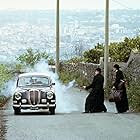A very well-made WWII film set in Italy, created shortly after the end of the conflict. It stands as a historical document portraying the tumultuous episodes of the shifting alliances within the Italian government, followed by the occupation of the territory and the birth of the Italian partisan resistance.
From a cinematographic standpoint, this movie can be seen as a precursor to neorealism due to its visual narrative and portrayal of characters. It's important to consider that the film was made during a historical period marked by severe scarcity of economic and technical resources, with the tragic wartime events still fresh. It's interesting to note that in the storytelling, the Allied forces are not portrayed at all as liberators of Italy; they are never mentioned, something that in later cinema would be almost impossible to overlook, given the strong post-war American presence in the country.
It's important to remember that during the filming of this movie, Italian politics was undergoing a crucial period. There was a strong Communist Party leading an anti-fascist movement, alongside an emerging Christian Democracy, both vying to fill the void left by fascism. The director, Aldo Vergano, had been a fervent communist and anti-fascist since the 1930s. It's interesting to observe how in the film, he attempts to depict this new Italian society emerging from the ashes of war.
The industrial bourgeoisie is portrayed as trying to relate to the working class, yet fundamentally living a life removed from social drama, despite ultimately facing the consequences themselves.
Narratively, the film presents very good ideas and moments of brilliance. The lead actors are all very believable, although only some truly shine in their roles. It's likely a small gem, entirely forgotten, that is worth rediscovering.






















